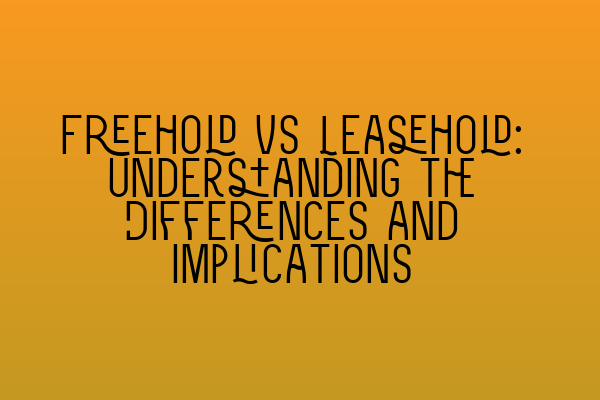Understanding the differences between freehold and leasehold properties is essential, whether you’re a property owner, buyer, or investor. The terms “freehold” and “leasehold” refer to the type of ownership you have over a property, and each comes with its own set of implications and considerations. In this blog post, we will dive into the differences between freehold and leasehold, helping you make informed decisions in the world of property law.
What is Freehold?
Freehold is the highest form of property ownership, giving you complete and absolute ownership of the property and the land it stands on. When you own a freehold property, you have full control over the property, including the right to make any alterations or modifications without seeking permission from anyone else. Freehold properties are typically houses or detached buildings, but they can also include commercial properties or land.
One of the key advantages of owning a freehold property is that you have unlimited rights and control. You are not subject to any ground rents or service charges, and you do not have to worry about the lease running out or having to extend it. Additionally, as a freeholder, you have the potential to benefit from any increase in property value over time.
If you are in the process of buying a freehold property, it is crucial to conduct thorough due diligence. This includes carrying out property searches, such as local authority searches, water and drainage searches, and environmental searches, to ensure there are no hidden issues that could affect the property’s value or use.
What is Leasehold?
Leasehold, on the other hand, is a form of property ownership where you own the property for a fixed period of time, as specified in the lease agreement. Essentially, you have a lease agreement with the freeholder, who owns the land the property is built on. Leasehold properties are commonly found in apartments, flats, and shared buildings, where multiple properties exist within the same building or development.
When you own a leasehold property, you are a tenant, and you have the right to occupy and use the property, subject to the terms outlined in the lease. The lease usually sets out the responsibilities of both the leaseholder and the freeholder, including any ground rent or service charges that may be payable. These charges are used to cover the costs of maintaining and managing the common areas and shared facilities of the building or development.
Leasehold properties come with certain obligations and restrictions. For example, you may need to seek permission from the freeholder to make any substantial alterations or modifications to the property. Additionally, leasehold properties have an expiration date, after which the ownership of the property reverts to the freeholder, unless the lease is extended. Extending the lease can be a complex legal process, and it is important to seek professional advice if you are considering doing so.
The Implications of Freehold vs Leasehold:
Now that we have discussed the basic concepts of freehold and leasehold, let’s delve deeper into the implications of each type of ownership.
1. Control and Freedom: Freehold properties offer the most control and freedom, allowing you to make decisions about your property without seeking permission. Leasehold properties, on the other hand, have certain restrictions and limitations, as outlined in the lease agreement.
2. Responsibilities and Costs: Freehold properties come with the responsibility of maintaining the property and land, but you have the freedom to choose service providers and negotiate the costs. In leasehold properties, the freeholder is typically responsible for maintenance and repairs of common areas, but you contribute through ground rent and service charges, which are often determined by the freeholder.
3. Lease Length: Leasehold properties have a fixed lease length, which can vary from a few decades to hundreds of years. As the lease term decreases, the value of the property may typically decrease as well, so it is important to consider the remaining lease term when buying or selling a leasehold property. Freehold properties do not have an expiration date, providing long-term ownership.
4. Selling and Financing: Leasehold properties can sometimes be more difficult to sell or obtain financing for, especially if the lease term is short. Lenders may be reluctant to provide mortgages for properties with short leases. Freehold properties, on the other hand, are generally easier to sell and finance.
5. Ground Rents and Service Charges: Leasehold properties often come with ground rents and service charges, which can increase over time. It is important to consider these costs when budgeting and assessing the affordability of a leasehold property. Freehold properties do not incur ground rents or service charges, providing more predictability and control over expenses.
In conclusion, understanding the differences and implications of freehold and leasehold properties is crucial for property owners, buyers, and investors. Freehold offers the highest form of ownership, providing complete control and ownership rights. Leasehold, on the other hand, grants the right to occupy and use a property for a fixed period, subject to the terms outlined in the lease agreement.
Whether you are considering buying a property or looking to invest, it is important to seek professional advice from a property law solicitor to fully understand the rights, obligations, and potential risks associated with freehold and leasehold properties. By educating yourself and making informed decisions, you can navigate the world of property ownership with confidence.
Related Articles:
– SQE 1 Practice Exam Questions
– SQE 1 Practice Mocks FLK1 FLK2
– SQE 2 Preparation Courses
– SQE 1 Preparation Courses
– SRA SQE Exam Dates
